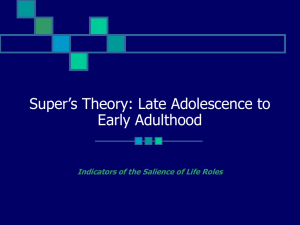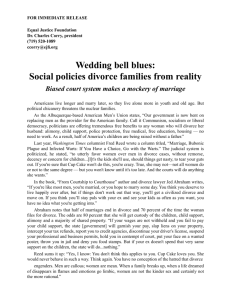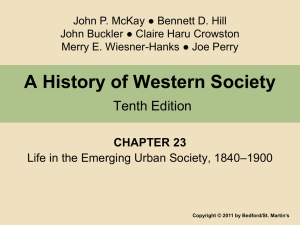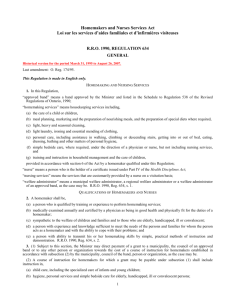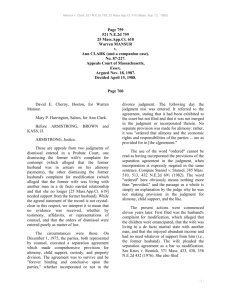Is Homemaking Service Really “Productive Labor?”
advertisement
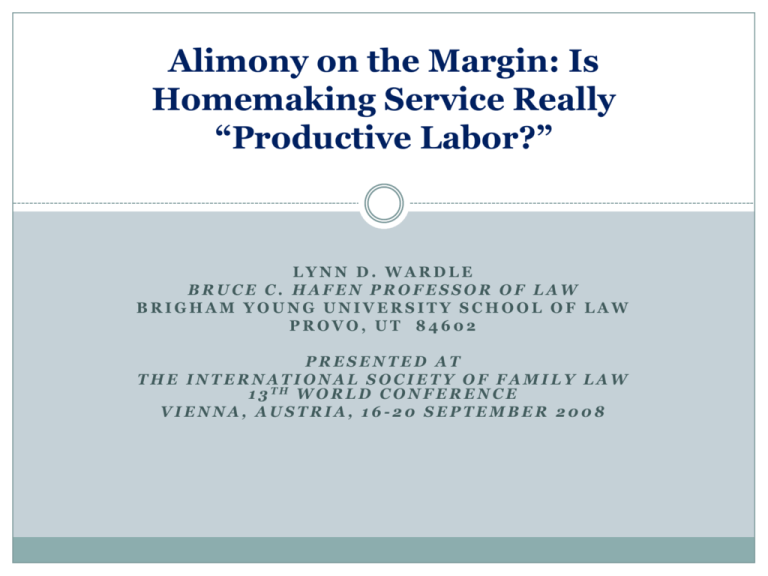
Alimony on the Margin: Is Homemaking Service Really “Productive Labor?” LYNN D. WARDLE BRUCE C. HAFEN PROFESSOR OF LAW BRIGHAM YOUNG UNIVERSITY SCHOOL OF LAW PROVO, UT 84602 PRESENTED AT THE INTERNATIONAL SOCIETY OF FAMILY LAW 1 3 TH W O R L D C O N F E R E N C E VIENNA, AUSTRIA, 16-20 SEPTEMBER 2008 Outline Alimony on the Margin: Is Homemaking Service Really “Productive Labor?” I. II. III. IV. Introduction: Focusing on Public Interests and Productive Labor. A. The Confused State of Alimony Doctrine and Justification B. The Conundrum of Alimony Law and Practice in America Homemaking is Productive Labor and Promotes Substantial Public Interests A. Homemaking Service Saves the Public Treasury Significant Costs. B. Homemaking Service Directly Generates Valuable Social Capital. C. Homemaking Services Reduces the Rate and Huge Costs of Marital Breakdown. D. Homemaking Service Produces More Secure, Well-Educated, LawAbiding, High-Performing and Productive Future Generations. Despite Governmental Disregard, Many American Women Recognize the Value of Homemaking Service and Organize their Lives to Give Maximum Homemaking Service Conclusion: Alimony in the Public Interest Should Recognize the Public Worth of Homemaking Service The Confused State of Alimony Doctrine and Justification The traditional labor division between husband and wife, with the husband-as-full-time-wageearner and wife-as-full-time-homemaker, no longer characterizes most marriages in the United States or in many of the developed nations around the world. Today, married women in most highly developed countries seem to prefer and pursue paid employment “productive labor” instead of homemaking service work. US Labor Statistics The percentage of women over 16 in the US workforce rose by two-thirds, from 36% in 1960 to 58% in 2000. Likewise, more on point, the US labor force participation rates among mothers of all children under 18 rose from 47.4% in 1975 to 72.9% in 2000 Alimony Alimony refers to support money which a court orders one divorcing spouse (typically the husband) to provide in some specific amount to his former spouse (typically the wife) after the dissolution of their marriage. Legal Justification The old legal justification for alimony (that the marriage had not formally ended, or the dissolution was due to the “fault” of the husband), ceased to justify alimony upon the adoption of no-fault divorce. As John Eekelaar and Mavis Maclean put it, “when the legislature [in the UK] made a definite . . . move away from the fault-based divorce in 1971, the only rationale for [the award of alimony] collapsed. . . . The retention of the fiction of the marital support obligation was no longer tenable.” Other Justifications Justifications for alimony are “private” (serve private economic interests) and “public” (serve public interests). Lots of “private interest” theories suggested, to no avail. Some have argued that alimony awards are contrary to the “public interest” in promoting the “productive labor” of all employable adults. I will suggest that homemaking is “productive labor,” and that there are compelling public interest justifications for awarding alimony in cases in which a good faith spouse has engaged in homemaking rather than in employment for pay. Alimony is best understood as an incentive to promote and protect investment by spouses in critical functions relating to child and family maintenance. Caveat: What This Paper is NOT Arguing This paper is not arguing that all (or any particular) married women or married mothers should be fulltime homemakers. How to balance the workfamily conflict is a decision every married woman and every mother must make for herself (advisedly in counsel with her husband). However, this paper argues that women who choose to engage in full-time homemaking service make valuable contributions to the public interest that deserve to be recognized in the law of alimony and elsewhere. U.S. Data on Divorces Cases Awarding Alimony Constance Shehan (2002): “Alimony awards are currently—and have historically been—rare in the US. . . . The portion of divorces in which alimony has been awarded has seldom exceeded 15%.” Robert Kelly & GL Fox (1993): Sample of 879 divorce cases from Oakland County, Michigan in the early 1980s; -Alimony awarded in divorce cases involving couples with a single income alimony 13.6% of the cases. -Alimony awarded in divorce cases involving dual income couples in only 6.5% of the cases. Robert Kelly & W Rinaman (2002): data from (NSFH) focusing on respondents who had first divorces between 1977-1988 and had dependent children, alimony (~) awarded in only 8.9% of the cases. “Margin” The “margin” referred in the title reflects the assumption that today alimony would be awardable only in “marginal” cases, not the bulk of cases, because so few married woman are full-time homemakers today. The Conundrum of Alimony Law and Practice in America Today courts in all American jurisdictions have the power to award “alimony” or “maintenance” to a divorcing spouse in at least some circumstances and for at least some period of time. However, alimony awards have become less common and more temporary. Today, it appears that alimony is awarded in relatively few cases, and the alimony awards usually are small or of short duration. Inadequate Justifications: Legal & Practical Unilateral no-fault divorce destroys the assumption that marriage is a lifelong obligation (or even, in some communities, that this is a reasonable expectation). “Need” no longer suffices because social and economic changes in the past thirty years have made it possible (and socially preferred) for women to obtain the same kind of education and jobs that men have. What justification is there now for ever ordering a man (usually) to continue to pay support to a woman to whom he is no longer married, who has (or is capable of obtaining) an education and a job that will provide her with enough salary to be fully self-sufficient? Many legal scholars have promoted many creative theoretical arguments to justify the general or more widespread award of alimony. Homemaking is Productive Labor and Promotes Substantial Public Interests The term “productive labor” refers to that which “produces or increases wealth or value” or “(chiefly in Marxist theory): that contributes to production; esp. in productive forces: the sources and determinants of productivity, as labor power, . . . the skills of the individual worker, etc..” For example, Adam Smith, in The Wealth of Nations wrote: “There is one sort of labour that adds to the value of the subject upon which it is bestowed: there is another which has no such effect. The former, as it produces a value, may be called productive.” Homemaking is “Productive Labor” Homemaking service is productive labor because: (1) Homemaking service saves the public treasury enormous costs, (2) (2) because homemaking service directly generates valuable social capital which benefits all members of society, (3) (3) because homemaking services reduces marital breakdown, dysfunction, and dissolution, and (4) (4) because homemaking service enhances and increases the stability and quality of marriage, parenting, and family life which produces more secure, well-educated, law-abiding, high-performing and productive future generations. Women who engage in homemaking service rather than paid employment are engaged in productive labor. Already, many American women organize their lives to maximize the time they can give to homemaking service and bypass economic-earning opportunities that would detract from or impair their homemaking. Marx, Engels, Lenin “In classical Marxist theory, as in early Soviet policy, the transformation of the family was perceived to be essential to the liberation of women. . . . It required a shift of functions from the family to the wider society.” Engels expressed the core assumption underlying the Marxist view of the family: “[T]he first condition for the liberation of the wife is to bring the whole female sex back into public industry, and . . . in turn demands that the characteristic of the monogamous family as the economic unit of society be abolished.” Lenin, also was “strongly opposed” to the individual household with its “stinking kitchen,” and dedicated to “sav[ing] woman from housewifery.” He wrote that a housewife was “a daily sacrifice to unimportant trivialities. . . . They are like worms which, unseen, slowly but surely rot and corrode.” Homemaking service saves the public treasury significant costs Homemaking service saves the public treasury significant costs A 2008 study by Salary.com (MA), a firm that studies workplace compensations, estimated that the annual value of homemaking services is $117,500 per year. Ric Edelman (6 times on Baron’s list of top financial advisers) of Edelman Financial Services estimated in 2008 that the value of homemaking servies is $773,700 per year. Homemaking Service Directly Generates Valuable Social Capital A social organism of any sort whatever, large or small, is what it is because each member proceeds to do his own duty with a trust that the other members will simultaneously do theirs. Wherever a desired result is achieved by the co-operation of many independent persons, its existence as a fact is a pure consequences of the precursive faith in one another of those immediately concerned. The family is the first schoolroom, where children learn duty, responsibility, self-control, obedience and other virtue essential for the functioning of democratic society. The level of public service and charitable service are highest among those who have been raised by a significant homemaker) Homemaking Has Constitutional Significance Michael Grossberg has written: “By charging homes with the vital responsibility of molding the private virtue necessary for republicanism to flourish, the new nation greatly enhanced the importance of women’s family duties. . . . At times ‘it even seemed as though republican theorists believed that the fate of the republic rested squarely, perhaps solely, on the shoulders of its womenfolk.’” De Tocqueville wrote: “[T]he American derives from his own home that love or order which he afterwards carries with him into public affairs.” Francis Grund: ”Change the domestic habits of the Americans . . . and it will not be necessary to change a single letter in the Constitution in order to vary the whole form of their government.” Homemaking Services Reduces the Rate and Huge Costs of Marital Breakdown The public costs of family marital break-up and of non- marital child-bearing (CBOW), total at least $112 billion each year for the USA, more than $1 trillion every decade. $70 billion in federal budget costs go to dealing with the consequences of marital break-down and avoidance every year, and family fragmentation costs state and local governments $42 billion every year. In Utah the state and local costs attributed to family fragmentation amount to 10.7% of the total tax burden, or $276 million per year. In California the state and local costs attributed to family fragmentation amount to11.5% of the total state and local tax burden, or $4.829 billion in taxes per year. W. Bradford Wilcox, Soft Patriarchs, New Men: How Christianity Shapes Father and Husbands (2004) Active Evangelicals (most) and Mainline Protestants (second) are more traditional gendered in family structure (husbands work, wives are primarily home-makers) than un-affiliated. Active Evangelicals and Mainline Protestants are both about one-third more affectionate as parents (hugging, kissing, and praising their children) than unaffiliated dads. “[W]ives of active Evangelical Protestant family men report the highest levels of happiness with the affection and the understanding that they receive from husbands, and they are followed fairly closely by wives of active mainline Protestant family men. Wives of unaffiliated family men report the lower levels of happiness.” Wives of active Evangelical Protestant family men report the lowest levels of violence (2.8 percent), followed by the wives of unaffiliated men (3.2 percent) and the wives of active mainline men (5.4 percent). Religious men and their wives, who tend to be follow homemaker gendered labor division, “enjoy happier marriages, they are less likely to father a child outside of wedlock, and they are more likely to take an active and affectionate approach to child rearing, compared to secular or nominally religious men.” Homemaking Service Produces More Secure, Well-Educated, Law-Abiding, High-Performing and Productive Future Generations. The potential risks to children raised in fragmented families that have been identified in the literature include mental illness, physical illness, infant mortality, lower educational attainment (including greater risk of dropping out of high school), juvenile delinquency, conduct disorders, adult criminality, and early unwed parenthood. “[T]he prevalence of delinquency in broken homes is 10-15 percent higher than in intact homes.” Gottfredson and Hirschi report that “[s]uch family measures as the percentages of the population divorced, the percentages of household headed by women, and the percentage of unattached individuals in the community are among the most powerful predictors of crime rates.” Likewise, a 2001 British study reported that boys living in permanently disrupted families on their fifteenth birthdays had significantly higher rates of delinquency, whether measured by delinquency convictions, selfreported juvenile delinquency, or adult convictions. Youths from broken homes (especially those broken by desertion) are most at risk of being maltreated, and maltreatment correlates strongly with delinquency. III. Despite Governmental Disregard, Many American Mothers Recognize the Value of Homemaking Service and Organize their Lives to Give Priority to Homemaking Service A 2007 poll by the respected Pew Research Center revealed that most American mothers of children under 18 prefer to work only part-time (50%) or to not work at all (30%) rather than full-time employment (20%). Only 16% of all mothers with pre-school aged children (0-4) desire full-time employment. Mothers who were employed rated themselves as significantly poorer parents (only 28 percent rated 9 or 10 out of 10) than part-time (41 percent) or not-employed (43 percent) mothers. Of the general population (41 percent) says that the trend toward mothers working outside the home is a bad thing for society (compared to 32 percent who say it makes not difference, and 22 percent who say it is a good thing). The movement of young mothers into paid employment correlated with the divorce boom in the 1970s and 1980s, and with the economic downturn of that era. Most married mothers work to supplement the level of benefits for their families, to enhance the level of personal benefits, and for social recognition, interaction, and achievement. The Bureau of Labor Statistics reports that women are more than twice as likely as men to work part time shows commitment of US working moms to homemaking. Also BLS date on tiered % of working mothers (of 0-2, lowest; of 3-5 next, of 6-18 highest percentage working). The persistence of the gender pay gap also attests to the continuing commitment of American working women to giving significant homemaking service. Conclusion: Alimony in the Public Interest It takes more faith to enter, maintain and seriously invest one’s life in a marriage today than in earlier times because divorce has become so common-place in and accepted by our society, and because our unilateral no-fault divorce laws convey a powerful message about the legal insecurity of the relationship. Homemaker service is “real” work. Homemaker service is “productive labor” Homemaker service contributes significantly to the public interest in encouraging “productive labor.” Alimony awards to full-time and near-full-time homemakers furthers the public interests in alimony of supporting “productive labor.” Awarding alimony to full-time homemakers is consistent with the historic “golden thread” of protecting the good faith investment by homemakers in marriage, to support the public interest in supporting investment in marital families, that runs through the centuries of alimony doctrine and practice. Since the introduction of no-fault divorce, this public interest has become obscured, lost.
